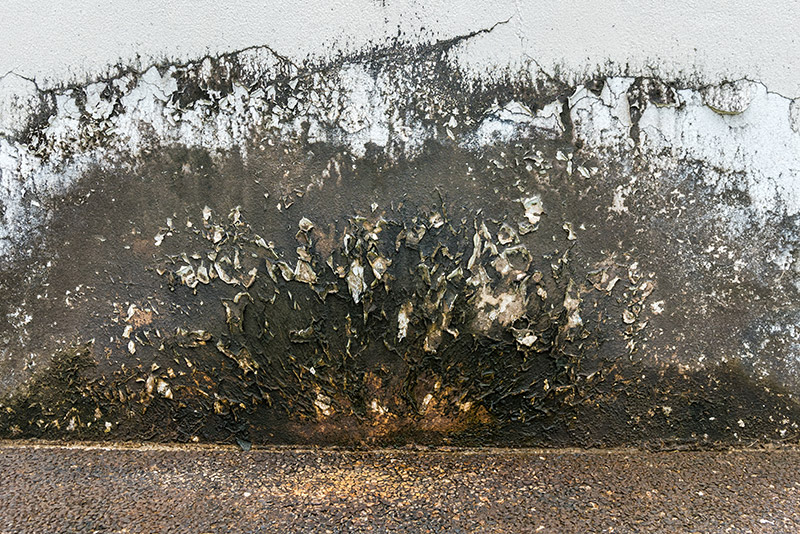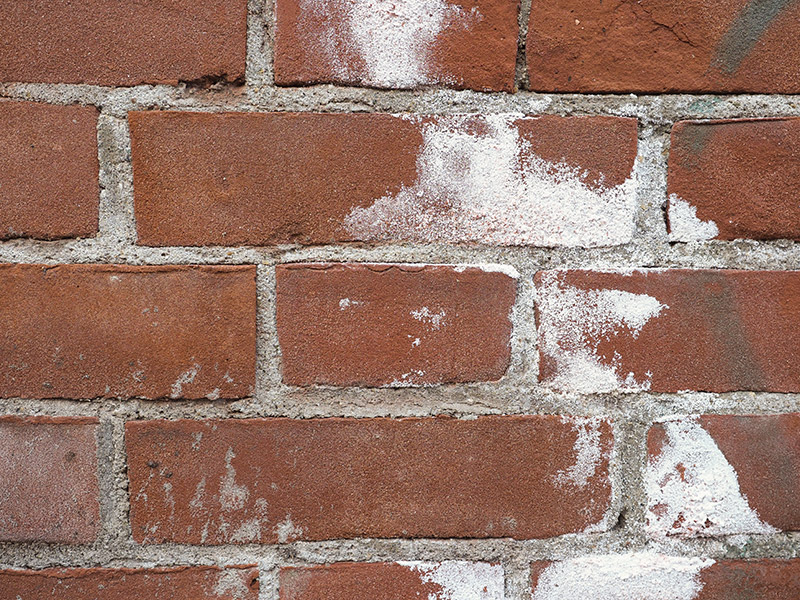White Mold in the Basement: What Is It, and How To Prevent It?
This page may contain affiliate links. If you make a purchase through one of our affiliate links, we’ll earn a commission, at no extra cost to you. For more details, please read our disclosure.

Finding white mold in the basement of your home is never ideal. All types of mold can cause health problems, although some are more dangerous than others. A white mold intrusion can cause numerous issues including respiratory problems, skin irritation, and infections, and can also have detrimental impacts on the structural integrity of your home if left untreated.
Of all the different types of mold, white mold is often the one that is most likely to be overlooked, given that it is often found in spaces that are hard to access or not regularly used as living spaces such as basements and garages. It is also frequently mistaken for efflorescence, a harmless crystalline substance deposit that is also commonly found in these areas.
In this article, we’re going to talk you through everything you need to know about white mold; how to identify it, how to get rid of it, and how to prevent any future re-growth. We will start off with the basics.
Related: Mold Behind Wallpaper? How to Remove It and Prevent It From Coming Back
Where Does White Mold in the Basement Grow and What Causes It?
The presence of white mold in the basement is most frequently found on concrete walls, cinder block walls, masonry, ceilings, floors, and wood (like floor joists). Indoor areas like basements and garages are often hotspots for these little spores to grow and multiply.
Because your basement is probably below ground level, it’s super easy for water to soak through the concrete, particularly if there is poor drainage in place or if the wall or floor slab has been cracked over time. Even without cracks, hydrostatic pressure can eventually force water through the concrete and will cause dampness and eventually mold growth. Another potential cause in basements is leaky pipes that leave water where it shouldn’t be.
Cold, damp environments are ideal for mold spores and the dust in the air that settle on these surfaces acts as food sources, providing the nutrients that the mold needs to grow. Infestation occurs in these types of conditions where it can thrive.
Humidity can also lead to mold growth, so if your basement is susceptible to condensation or being wet, you’re more likely to see some mold growing in there. Moisture is the key catalyst to mold growth. Even with large amounts of dust or dirt in your basement, if there is no moisture in the air, no mold can grow.
Using a hygrometer is a great way to check and monitor the humidity levels in your home to ensure that there is no excessive moisture in the air that would cause an issue. If you do have moisture issues, try using a dehumidifier even if you have no signs of mold yet. Run the dehumidifier to reduce moisture in warm weather and even during winter months if humidity remains high.
| Image | Product | Our Rating | Price |
|---|---|---|---|
Top Choice  | ThermoPro TP50 Digital Hygrometer Indoor Thermometer
| 9.7 | Check Price on Amazon |
Best Value  | ThermoPro TP49 Digital Hygrometer Indoor Thermometer Humidity Meter
| 9.7 | Check Price on Amazon |
Two-Pack  | Indoor Humidity Thermometer Hygrometer
| 9.5 | Check Price on Amazon |
What is White Mold?
There are countless types of mold, many of which are often found in the home, and many of which are white in color with no obvious odor. Even black or green molds can start out white in color, so it can be difficult to tell exactly which type of mold you are dealing with and what risk you’re facing.
It’s also not always necessary to identify the exact strain of mold that is present within your home’s interior, as most mold spores can be removed and prevented using similar methods.
Essentially, white mold is a fungus that has a powdery, fluffy, fuzzy, or slimy consistency, depending on the surface it has infected.
White Mold or Efflorescence?

White mold and efflorescence are commonly mistaken for one another. Their appearance and texture are very similar and you’re likely to see them present in the same areas of homes, such as basements and garages.
However, the two are actually very different. While exposure to white mold can be harmful, efflorescence is mostly harmless and is unlikely to have any negative impacts on your own health or the safety of your home.
Efflorescence appears when moisture moves through concrete (or block or brick) and leaves behind salty mineral deposits in the spot of the drain. These deposits then form a white, crystalline growth that can look a lot like white mold.
Identifying whether you have white mold or efflorescence present in your basement is pretty straightforward. Simply spray some water over the surface, if the white substance disappears, it is efflorescence, if it doesn’t, it is probably white mold.
Related: My Closet Smells Like Mildew (How to Fix It)
Removing White Mold
If you establish that the white substance growing in your basement is, in fact, white mold, you should aim to remediate it as quickly and thoroughly as possible. Because concrete is super durable and not prone to surface damage, remediation or removing the mold should be pretty straightforward. To do this, you will need to follow the next few steps:
Step 1: Locate the Mold
The first thing you should do is try to identify and uncover all of the mold. To do this, you might need to move around furniture and boxes, since these are typically the areas where you are most likely to see excess moisture and mold growth.
If the mold is extensive, it might also be worth carrying out a mold test, either by using your own testing device or by calling in a professional. This will tell you whether there is mold present inside the wall cavities, causing infrastructural damage and potentially leading to safety hazards within your home.
Related: Mold on Carpet: How to Get It Out Without Chemicals
Step 2: Segregate the Affected Area
Once you have identified all of the white mold in the basement, it is super important that you seal off the area to prevent the contamination of other areas while disturbing and removing the mold spores.
Cover doorways if possible and seal off ventilation ducts to prevent the mold from settling in them. It is also extremely vital at this point that you take every necessary step to protect yourself. Protective clothing should be worn while dealing with mold, particularly in sealed spaces.
 ZipWall ZipDoor ZDS Standard Dust Barrier Zipper Door Kit
ZipWall ZipDoor ZDS Standard Dust Barrier Zipper Door Kit
Ensure you are wearing gloves, goggles, hair and shoe covers, and a mask to prevent any health issues. Remove these whenever you leave the area and store them in a sealed bag to stop the mold spores from contaminating other areas of your home.
Step 3: Remove and Clean any Soft Furnishings or Porous Materials
If you have curtains, sofas, cushions, clothes, or any other porous materials in the basement, remove these first and transport them in a sealed container to have them washed separately to any other laundry. Wash them according to their care labels, and if possible, opt for a hot wash setting to ensure all mold spores are killed.
Related: How to Deep Clean a Couch
Step 4: Remove the Mold Spores
Next up, take a scrubbing brush along with your choice of natural cleanser (most liquid soaps or detergents will work), or you can make your own using white vinegar and distilled water.
For a more thorough clean, which may be necessary, take some hydrogen peroxide and use this to scrub the area and remove the bacteria before it grows
After going in with the hydrogen peroxide, take your cleanser once again and spray this over the entire area before taking a clean microfiber cloth and wiping the walls, ceilings, or flooring.
 E-Cloth General Purpose Microfiber Cleaning Cloth
E-Cloth General Purpose Microfiber Cleaning Cloth
Preventing Re-Growth
The final, and arguably the most important step, is to prevent the growth of white mold in the basement.
To do this, establish the cause of the mold growth. If there is a leak somewhere in your basement or foundation, you will need to have this fixed or the mold will almost certainly return in the future.
If the cause is excess moisture or humidity, consider investing in a dehumidifier unit or improving the ventilation in the space to deal with this problem. A fan may also be helpful.
| Image | Product | Our Rating | Price |
|---|---|---|---|
Top Choice  | Kesnos 70 Pint Dehumidifier
| 9.8 | Check Price on Amazon |
Best Value  | hOmeLabs Dehumidifier
| 9.7 | Check Price on Amazon |
 | Honeywell Energy Star Dehumidifier
| 9.5 | Check Price on Amazon |
It is also a good idea to regularly clean your basement using hydrogen peroxide or liquid soap, such as a castile soap, for proper removal of any dust and bacteria that mold spores can feed off of.
Related: Natural Mold Removal: Safe and Non-Toxic Methods and The Best Essential Oils for Mold Prevention and Removal
Final Thoughts on White Mold in the Basement
White mold in the basement is not only unsightly, but it can be toxic and may cause major harm to you and anyone else in your household if left untreated. In addition to health risks, it can cause extensive infrastructural damage to your home or building and may result in you having to pay out for some costly repairs if it’s not dealt with quickly.
Using the guidance laid out here, you should be able to accurately identify white mold in your basement or anywhere else in the home and remove it quickly and effectively to prevent these issues and stop it from re-growing in the future.
As with any type of mold, be sure to take all necessary safety precautions when carrying out these steps to prevent any harm to yourself or your family.

